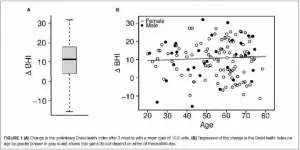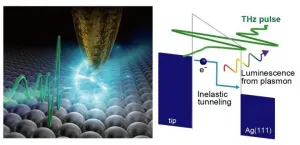(Press-News.org) Brazilian researchers who study a native venomous fish have confirmed a route to drug development for the treatment of chronic inflammatory diseases such as multiple sclerosis and asthma.
The venomous toadfish Thalassophryne nattereri contains a peptide (TnP) with anti-inflammatory and anti-allergic potential. Confirmation of this potential has now come via the zebrafish Danio rerio, a popular aquarium species native to South Asia that shares 70% of its genome with humans and is widely used as a model for in vivo trials in drug development.
The researchers tested TnP in D. rerio to measure its toxicity. In a little over a year, their research showed that the peptide is safe. It did not cause cardiac dysfunction or neurological problems in the toxicity tests they performed.
The study was conducted at Butantan Institute's Special Laboratory for Applied Toxinology in São Paulo (Brazil) by researchers affiliated with the Center for Research on Toxins, Immune Response and Cell Signaling (CeTICS), one of the Research, Innovation and Dissemination Centers (RIDCs) funded by São Paulo Research Foundation - FAPESP.
In addition to proving the peptide's safety when used as an anti-inflammatory agent, the results reinforce the importance of D. rerio as an alternative animal model for drug development that saves time and money.
Preclinical trials are important to prove the efficacy (therapeutic activity) of molecules in vivo and to evaluate adverse effects and safety. In drug discovery, 98% of the compounds tested in animals are abandoned before clinical tests.
In an article published in Toxicology Reports, the researchers say peptides represent about 2% of the world drug market but even so account for a market share worth about USD 20 billion.
"The results highlight a wide therapeutic index for TnP with non-lethal and safe doses from 1?nm [nanometer] to 10?μm [micrometer], without causing neurotoxicity or cardiotoxic effect. The low frequency of abnormalities [caused] by TnP was associated with the high safety of the molecule and the developing embryo's ability to process and eliminate it. TnP crossed the blood-brain barrier without disturbing the normal architecture of forebrain, midbrain, and hindbrain [the three main developmental divisions of the brain]," the authors write.
The study resulted from the master's research of João Batista-Filho, supervised by Mônica Lopes Ferreira and Carla Lima da Silva. It used the Zebrafish Platform, launched in 2015 by CeTICS (read more at: agencia.fapesp.br/22156/).
The Zebrafish Platform is available to scientists for research, offers courses on zebrafish management and biology, and does scientific dissemination. More than 160 researchers at 100 private and public institutions currently collaborate via Zebrafish Network, also created by CeTiCS.
"Science dies out without investment and FAPESP's commitment to this platform is now bearing fruit," Ferreira told. "Cutting-edge research is being done here, alongside preclinical trials that are important both to academia and industry."
Zebrafish have been used for decades in trials held in other countries, she said, adding that Brazil is closing the gap and that the animal's rapid life cycle accelerates the research process.
The freshwater species is easy to manage, reproducing fast, developing from egg to larva in 48-72 hours, and reaching adulthood at only three months of age. Zebrafish embryos are transparent and the effect of a compound on the animal's organs can easily be observed, for example.
History
Ferreira and collaborators discovered TnP (T. nattereri peptide) in 2007. Meanwhile, Lima had standardized laboratory tests to evaluate multiple sclerosis in rodents. The two researchers decided to work together to test TnP's efficacy in treatment of the disease, concluding for its anti-inflammatory and immunomodulatory functions.
The TnP family encompasses synthetic peptides containing a sequence of 13 L-amino acids in their primary structure. Synthetic products derived from TnP have been patented in at least nine countries including the US, India and Japan, as well as the EU. In Brazil, a patent application has been filed in partnership with the pharmaceutical company Cristália.
Studies conducted by the group with mice between 2013 and 2015 had already demonstrated that TnP can treat multiple sclerosis, delaying the onset of severe symptoms and improving clinical signs of the disease.
Multiple sclerosis is a chronic autoimmune inflammatory disorder of the central nervous system, in which the immune system attacks the myelin sheath that protects nerve fibers in the brain, spinal cord and optic nerves, disrupting communication with the rest of the organism. It can cause muscle weakness, vision loss, pain, and impaired motor coordination. It affects some 2.5 million people worldwide, including about 35,000 in Brazil, according to the Brazilian Multiple Sclerosis Association (ABEM).
Safety
In the article published in Toxicology Reports, the researchers say drug-induced cardiotoxicity is the main reason for drug withdrawal from the market. "For instance, between 1994 and 2006, 45% of discontinued medications had adverse effects such as cardiac ischemia and arhythmogenesis. In this line zebrafish has emerged as a model organism for cardiovascular research, investigating gene function and modeling a variety of human disease side-effects of chemotherapeutic drugs or particularly to screen drug candidates," they note.
For Batista-Filho, the study provides more evidence for the value of the zebrafish model in preclinical research. "It doesn't substitute mice, but avoids future expense on molecules that may not be promising or prove too toxic in previous phases," he said when asked about reservations regarding the use of zebrafish in trials compared with rodents.
Advocating investment in science and research in Brazil, Batista-Filho said he was overjoyed to achieve publication of his master's dissertation in a scientific journal. "I'm delighted," he said. "Publication is a milestone for any scientist. You focus on the good that research can do, but publication is recognition for the team's hard work."
INFORMATION:
About São Paulo Research Foundation (FAPESP)
The São Paulo Research Foundation (FAPESP) is a public institution with the mission of supporting scientific research in all fields of knowledge by awarding scholarships, fellowships and grants to investigators linked with higher education and research institutions in the State of São Paulo, Brazil. FAPESP is aware that the very best research can only be done by working with the best researchers internationally. Therefore, it has established partnerships with funding agencies, higher education, private companies, and research organizations in other countries known for the quality of their research and has been encouraging scientists funded by its grants to further develop their international collaboration. You can learn more about FAPESP at http://www.fapesp.br/en and visit FAPESP news agency at http://www.agencia.fapesp.br/en to keep updated with the latest scientific breakthroughs FAPESP helps achieve through its many programs, awards and research centers. You may also subscribe to FAPESP news agency at http://agencia.fapesp.br/subscribe.
Health care systems could save lives and minimize losses by optimizing resource allocation and implementing mitigation strategies, according to two new studies. Colorado State University researchers explored how our health care systems might perform under multiple disasters and multiple waves of COVID-19, and how we can keep them functioning when we need them most.
In the first study, published in Nature Communications, Civil and Environmental Engineering Ph.D. student Emad Hassan and Associate Professor Hussam Mahmoud investigated the compound effects of pandemics and natural disasters on health care systems. They combined wildfire ...
DALLAS (March 9, 2021) - Better brain health and performance for humankind is one step closer to reality with the successful trial of the groundbreaking BrainHealth Project. A cross-disciplinary team with the Center for BrainHealth® at The University of Texas at Dallas unveiled an easy-to-use online platform that delivers a novel, science-backed approach to measuring, improving and tracking one's own brain fitness.
A key innovation of the Project centers on the BrainHealth Index™ (BHI), which is based on a multidimensional definition of brain health and its upward potential. The BHI is a composite derived from a series of best-in-class assessments that explore ...
Farmers in the Midwest may be able to bypass the warming climate not by getting more water for their crops, but instead by adapting to climate change through soil management says a new study from Michigan State University.
"The Midwest supplies 30% of the world's corn and soybeans," said Bruno Basso, an ecosystems scientist and MSU Foundation Professor in the Department of Earth and Environmental Sciences within the College of Natural Science. "These crops are sensitive to temperature and water changes."
Previous studies have suggested that by 2050, the Midwest will need about 35% more water to sustain its current levels of corn and soybean yields. But research done by Basso and colleagues found that the data does not support this idea. The Midwest is in a unique location that ...
If past natural disasters have taught us anything about their effects on pregnant women and developing babies, it is to pay close attention, for the added stress will surely have an impact on them. Amanda Venta, associate professor of psychology at the University of Houston, is sounding that alarm as it relates to the COVID-19 pandemic in a newly released study published in Child Psychiatry & Human Development.
"There is strong evidence to suggest that the coronavirus pandemic will affect mothers and infants through immune pathways that, in previous research, have been shown to link stress and social isolation during the pre- and post-natal periods with deficits in maternal mental health and infant well-being and development across developmental stages," reports Venta.
Research ...
The relationship between the Hawaiian bobtail squid and the bioluminescent bacteria living in its light organ has been studied for decades as a model of symbiosis. Now researchers have used a powerful chemical analysis tool to identify a small molecule produced by the bacteria that appears to play an important role in their colonization of the light organ.
The study, published March 9 in the journal mBio, adds a new wrinkle to scientists' understanding of the chemical signaling involved in this iconic symbiotic relationship. "It's exciting that there are still new things to discover, even in such a well-studied system," said corresponding author Laura Sanchez, associate professor ...
A new systematic review of evidence recommends the use of behavioral self-management treatments for common urinary issues experienced by upwards of 70 percent of older men. Common symptoms include trouble urinating, increased frequency and incontinence. These symptoms can have a substantial negative impact on sleep, social functioning and quality of life. Several guidelines recommend self-management techniques like health education, advice on fluid intake, and bladder retraining; however, in practice, self-management is often excluded from the menu of treatment options that include medication and surgery.
Researchers at Bond University's Institute for Evidence-Based Healthcare found that self-management interventions reduced the severity of lower urinary tract symptoms. The ...
Wormholes play a key role in many science fiction films - often as a shortcut between two distant points in space. In physics, however, these tunnels in spacetime have remained purely hypothetical. An international team led by Dr. Jose Luis Blázquez-Salcedo of the University of Oldenburg has now presented a new theoretical model in the science journal Physical Review Letters that makes microscopic wormholes seem less far-fetched than in previous theories.
Wormholes, like black holes, appear in the equations of Albert Einstein's general theory ...
A mobile app designed to help women manage urinary incontinence was as effective as usual, in-person treatment of incontinence in primary care, according to new research from the Netherlands. The study included 262 women with frequent stress incontinence, overactive bladder or a mix of symptoms. Participants were randomly assigned to use a standalone mobile app called URinControl, which offered pelvic floor muscle and bladder training exercises. Those in a control group received standard care and were referred to their own primary care doctors who were broadly advised to follow the Dutch guidelines for primary care. After four months, ...
Since the early 2010s, ultrafast probing of materials at atomic-level resolution has been enabled by terahertz scanning tunneling microscopes (THz-STM). But these devices can't detect the dissipation of energy that happens during events such as when photons are emitted via recombination process of an electron-hole pair in a light emitting diode (LED). However, a new technique allows the tracking of just such energy dynamics alongside THz-STM, opening up new avenues of investigation for nanoscale science and technology.
Researchers in Japan have developed a microscopy technique that combines the ability to manipulate the motion of electrons on a femtosecond timescale ...
According to two national surveys by researchers at the University of Michigan Medical School, US teens and young adults are engaged in the ongoing COVID-19 pandemic with most being knowledgeable about the disease, concerned about its impacts on others, and practicing social distancing. On March 6, 2020, 70 percent reported knowledge of the pandemic, with 46 percent noting they got information from news sources. By March 20, 2020, nearly all respondents, 95 percent, reported impact. Worry about the pandemic increased from 25 to 51 percent. For some young people who weren't worried early on about the pandemic, staying at home and engaging in other preventive public health guidelines made them feel safer. Between the two surveys, pandemic preparation seemed to shift. ...




